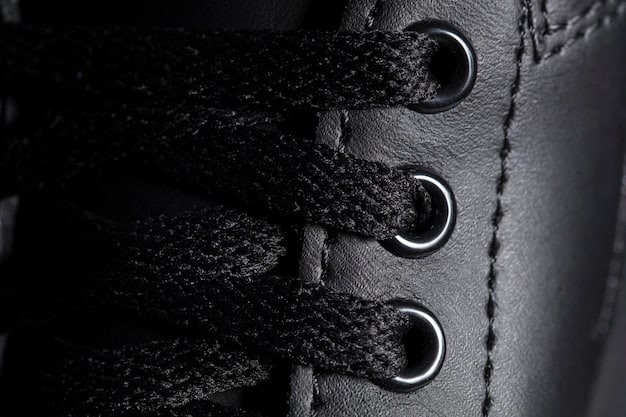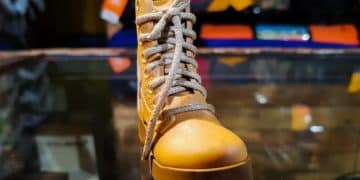Streetwear Authenticity: Guarding Your Investment from Fakes

Navigating the complex world of streetwear requires vigilance, as the proliferation of counterfeit merchandise threatens investments and compromises the subculture’s integrity. Identifying authentic streetwear involves meticulous examination of details, understanding brand-specific markers, and relying on reputable sources to safeguard purchases.
In the vibrant and ever-evolving landscape of contemporary fashion, few subcultures capture attention quite like streetwear. From exclusive sneaker drops to limited-edition apparel, the allure often lies in scarcity and brand prestige. However, this booming market also presents a significant challenge: the pervasive issue of counterfeit goods. Understanding Streetwear Authenticity: Spotting Fake Merchandise and Protecting Your Investment is no longer just a nuanced skill for collectors; it’s a vital defense for anyone participating in this dynamic scene.
the rising tide of fakes: a threat to streetwear culture
The global counterfeit market is a multi-billion-dollar industry, with luxury goods and streetwear often at its epicenter. This illicit trade not only defrauds consumers but also undermines the very brands and designers that fuel the culture. Understanding the magnitude of this problem is the first step in combating it. Counterfeiters have become increasingly sophisticated, making it challenging for even seasoned enthusiasts to differentiate between genuine and fake items. Their methods mimic intricate details, from stitching patterns to packaging, making forensic-level observation essential.
the economic and cultural impact of counterfeits
The economic toll of fake streetwear is staggering. Brands lose revenue, impacting their ability to innovate and maintain quality. Consumers are robbed of their hard-earned money and the prestige associated with owning a genuine article. Beyond finances, the cultural impact is equally profound. Streetwear thrives on exclusivity and storytelling; fakes dilute this narrative, potentially eroding trust within the community. When replicas become indistinguishable to the untrained eye, the value of authenticity diminishes, devaluing the craft and artistic vision.
- Loss of Revenue: Brands suffer significant financial losses, affecting research, development, and employee wages.
- Consumer Fraud: Buyers are tricked into purchasing inferior products at inflated prices, devaluing their investment.
- Brand Devaluation: The market is flooded with low-quality replicas, tarnishing brand reputation and exclusivity.
- Threat to Innovation: Reduced profits can hinder a brand’s ability to invest in new designs and technologies.
the sophistication of counterfeit operations
Modern counterfeit operations are not back-alley enterprises; they are often highly organized, leveraging advanced manufacturing techniques and global distribution networks. They meticulously study authentic products, sometimes even acquiring genuine samples to dissect and replicate. This dedication to mimicry means that what was once a clear distinction—a poorly printed logo or an off-color fabric—is now much harder to discern. They exploit loopholes in international shipping and customs, making interception incredibly difficult. Consumers must therefore become their own front-line defenders, equipped with knowledge and critical observation skills. The supply chain for fakes is often opaque, making it hard to track their origins. Public awareness campaigns and stricter regulations are critical components in addressing this widespread problem.
mastering the art of authentication: general guidelines
Authenticating streetwear goods requires a keen eye and a systematic approach. While specific details vary by brand, several universal indicators can help you spot a fake. Think of yourself as a detective, looking for clues in every stitch, tag, and material. This vigilance protects not only your wallet but also the integrity of your collection. Developing an intuitive sense for genuine products comes from experience and a commitment to detail.
examine the details: quality and craftsmanship
High-quality streetwear brands invest significantly in materials and craftsmanship. This attention to detail is often the first giveaway for fakes. Look for consistent stitching, high-quality fabrics, and precise cuts. Authentic items will rarely have loose threads, uneven seams, or fading prints. Counterfeiters often cut corners on these less visible aspects. Pay attention to the weight and texture of the fabric; cheap imitations often feel thin or coarse compared to their genuine counterparts. The overall finish of an item—how it feels in your hand and drapes on the body—is often a strong indicator of its authenticity. Examine zippers, buttons, and other hardware; genuine brands use durable, well-finished components, not flimsy, generic ones.
logos, branding, and typography
Logos are perhaps the most immediately recognizable element of any streetwear brand. Counterfeiters often struggle to perfectly replicate complex logos, brand typography, and specific color palettes. Look for crisp, clear printing or embroidery, correct spacing between letters, and the exact shade of brand colors. Slight variations in font, thickness, or placement can be red flags. Some brands use specific holographic stickers or unique security threads in their tags, which fakes often miss.
- Font Consistency: Pay close attention to the font style and size of brand names and product details.
- Color Accuracy: Compare the colors of logos and designs to official brand images.
- Logo Placement: Ensure the logo is placed exactly where it should be, with correct alignment.
- Embroidery Quality: For embroidered logos, check for dense, even stitching with no loose threads.
packaging and accessories: subtle but telling clues
Authentic streetwear often comes with distinct packaging, hangtags, and sometimes even dust bags or special boxes. Counterfeiters may replicate these, but often with lower quality materials or incorrect details. Check the spelling on all tags and boxes; misspellings are a common sign of a fake. The quality of the paper, the print resolution, and the feel of the packaging can also be indicative. Genuine products often include detailed care instructions or authenticity cards. These subtle inclusions, easily overlooked, can be critical differentiators. For premium items, such as sneakers, the shoe box itself is a key component of authenticity; examine its print quality, labels, and overall construction.
brand-specific nuances: deep dive into popular streetwear labels
While general guidelines are helpful, true authentication prowess comes from understanding the specific characteristics of individual brands. Each major streetwear label has its own unique markers that alert experts to authenticity. Knowing these specific details is key to navigating the market with confidence and making informed purchasing decisions.
supreme: box logo and tag intricacies
Supreme is arguably one of the most counterfeited streetwear brands due to its immense popularity and limited drops. The iconic box logo is a prime target for fakes. Authentic Supreme box logos, whether on T-shirts, hoodies, or accessories, feature precise, crisp white lettering on a rich, vibrant red background. Look for the exact shade of red and the specific font (Futura Heavy Oblique, often slightly condensed). The stitching around the box logo is crucial: it should be neat, even, and consistent.
Authenticity extends to the neck tags and wash tags. Genuine Supremeneck tags are typically thick cotton, with specific font and placement. Wash tags contain detailed information about manufacturing location and composition; often, fakes will have generic or incorrect information here. Pay attention to the quality of the fabric on hoodies and sweatshirts; genuine Supreme uses heavy, high-quality fleece. The drawstring loops on hoodies should be neatly stitched, not flimsy or poorly executed.
bape: camo patterns and ape head details
BAPE (A Bathing Ape) is another brand heavily targeted by counterfeiters, largely due to its distinctive camo patterns and Ape Head logo. The quality and pattern of BAPE’s camo are critical. Authentic BAPE camo patterns are intricate and detailed, with precise color separation and rich tones. Fakes often have blurry, faded, or incorrectly colored camo.
The Ape Head logo, whether on tags, patches, or prints, is highly detailed. Authentic Ape Heads will have sharp, defined lines, with specific features that counterfeiters often distort. Look closely at the eyes, nose, and mouth of the ape; slight misalignments or distortions indicate a fake. The ‘WGM’ (World Gone Mad) logo often seen on BAPE hoodies should also be meticulously checked for precise stitching and alignment. Zipper details, particularly the iconic shark head full-zip hoodies, are another tell-tale sign; authentic BAPE zippers are heavy-duty and branded.
off-white: zip ties, tags, and text placement
Off-White’s signature aesthetic involves distinctive branding elements like zip ties, diagonal stripes, and bold text. The zip tie itself is a common point of contention. Authentic Off-White zip ties are typically beige or red, with specific serial numbers and branding details. They should be securely attached and made of a durable material. Fakes often use flimsy or incorrect plastic.
The diagonal stripes and text placement are also crucial. Authentic Off-White stripes are precisely spaced and proportioned; too wide, too narrow, or incorrect spacing are signs of a fake. Typography is key for Off-White, as specific fonts and precise text placement are part of its design. Check spelling and alignment carefully. The quality of the fabric, stitching, and metal hardware on clothing items like belts and bags should also be meticulously examined; genuine Off-White uses premium materials. The “ART” tag attached to some garments is a small detail that counterfeiters often overlook or replicate poorly.
fear of god/essentials: fabric, fit, and subtle branding
Fear of God and its more accessible ESSENTIALS line emphasize fabric quality, oversized fits, and subtle branding. Authentic Fear of God garments use premium, often heavy-weight fabrics with a luxurious feel. Fakes will typically use thinner, cheaper materials. The fit is also a major characteristic; Fear of God is known for its distinctive oversized and relaxed silhouettes, which can be hard for counterfeiters to replicate perfectly.
Branding on Fear of God and ESSENTIALS is often understated, relying on high-quality embroidery or embossed logos rather than large prints. Check the “FEAR OF GOD” or “ESSENTIALS” text on tags and garments for crisp, clean execution. The rubberized patches on some items should be well-formed and securely attached. Drawstrings and metal hardware on genuine items are also high quality, often custom-branded. The subtle nuances of these brands make them difficult to fake perfectly, but require a discerning eye to spot the differences.
leveraging technology and community: modern authentication tools
The fight against fakes isn’t fought alone. Technology and community resources have emerged as powerful allies in authenticating streetwear. From online databases to expert communities, these tools provide invaluable support for consumers seeking peace of mind. Staying informed about these resources can significantly enhance your ability to make safe and authentic purchases.
online authentication services
Several reputable online authentication services specialize in streetwear and luxury goods. Platforms like Legit Check App (LCG), CheckCheck, and AuthenticateFirst employ expert authenticators who can verify items based on high-resolution photos. These services often have comprehensive databases of authentic products and stay updated on the latest counterfeiting techniques. While these services come with a fee, the cost is often negligible compared to the loss incurred from buying a high-priced fake. They provide an objective, third-party opinion that can be crucial for high-value items.
online communities and forums
Reddit communities (e.g., r/FashionReps, r/LegitCheck) and dedicated fashion forums are goldmines of information. Experienced collectors and enthusiasts often share detailed guides, side-by-side comparisons of genuine vs. fake items, and offer advice. These communities are vital for understanding brand-specific tells and staying informed about new counterfeiting trends. However, be cautious and cross-reference information; not all advice online is accurate, and some users may inadvertently spread misinformation. Engaging with these communities can build your knowledge base and provide a network of support.
- Detailed Guides: Access comprehensive guides compiled by experienced collectors.
- Comparison Photos: View side-by-side images highlighting differences between genuine and fake items.
- Expert Advice: Receive direct feedback and insights from knowledgeable community members.
- Trend Spotting: Stay updated on the latest counterfeiting methods and brand-specific updates.
qr codes and nfc tags: brand-led authenticity
Some contemporary brands are integrating technology directly into their products to combat counterfeits. QR codes, NFC (Near Field Communication) tags, and blockchain-based authentication systems allow consumers to verify an item’s authenticity simply by scanning a tag with their phone. While not universal, this trend is growing, particularly among brands that prioritize transparency and consumer trust. Always check the brand’s official website to see if they offer such features, and be wary of generic or non-functional codes on suspect items. This direct-to-consumer authentication provides immediate peace of mind.
where to buy authentic streetwear: navigating the retail landscape
Knowing where to buy is just as crucial as knowing how to authenticate. The retail landscape for streetwear is diverse, ranging from official brand stores to consignment shops. Choosing reputable sources significantly reduces your risk of encountering fake merchandise, ensuring your investment is protected and your style is genuinely on point.
official brand channels and authorized retailers
The safest bet for purchasing authentic streetwear is directly from the brand’s official website or one of its authorized retailers. This includes flagship stores, brand-owned e-commerce sites, and approved department stores or boutiques. These channels guarantee authenticity and often come with customer service and return policies that protect your purchase. Signing up for brand newsletters or following their social media accounts can provide alerts for new drops and collaborations, ensuring you get items directly from the source.
reputable resale platforms and consignment stores
The secondary market is a huge part of streetwear culture, with many items only available through resale. Platforms like StockX, GOAT, Stadium Goods, and The RealReal have built strong reputations for authenticating items before they reach the buyer. They employ their own teams of experts to verify every product.
However, even on these platforms, vigilance is advised. While they offer a high level of security, no system is foolproof. Understand their authentication processes and return policies. For physical consignment stores, research their reputation, read reviews, and ask about their authentication methods. Building a relationship with a trusted local reseller can also be beneficial, as they often have years of experience.
avoiding high-risk sources: online marketplaces and unknown sellers
Online marketplaces like eBay, Facebook Marketplace, or even general e-commerce sites can be high-risk environments for buying streetwear. While legitimate sellers exist, these platforms are also breeding grounds for counterfeiters. Be extremely cautious when dealing with unknown sellers, especially if prices seem too good to be true.
Look for sellers with extensive positive feedback, clear photos of the actual item (not stock photos), and a willingness to provide additional verification details like original receipts or specific close-up shots. Avoid sellers who refuse to answer questions, have generic listings, or pressure you to complete transactions outside the platform’s secure payment system. If in doubt, it’s always better to walk away. The risk of losing your money and ending up with a worthless fake far outweighs the allure of a cheap deal.
what to do if you encounter a counterfeit: taking action
Discovering you’ve purchased a counterfeit item can be incredibly frustrating. However, taking the right steps can help you mitigate your losses, report fraudulent activity, and prevent others from falling victim to similar scams. Your actions contribute to a stronger, more authentic streetwear community.
reporting fraudulent sellers and transactions
If you’ve bought a fake, report the seller to the platform where the transaction occurred. Most legitimate marketplaces have robust reporting systems for counterfeit goods. Provide as much detail as possible, including photos, communication logs, and transaction IDs. This helps the platform investigate and potentially ban the seller, protecting other users. Some payment processors, like PayPal or credit card companies, also offer buyer protection and dispute resolution services for fraudulent transactions. Act quickly, as there are often time limits for filing claims.
seeking refunds and disputing charges
Immediately contact the seller to request a refund. If they are unresponsive or refuse, escalate the issue through the platform’s dispute resolution process. If the purchase was made with a credit card or through a payment service (like PayPal), initiate a chargeback or dispute. Provide all evidence that the item is counterfeit. While it can be a lengthy process, many consumers successfully recover their funds. Be persistent and well-documented in your claims.
educating yourself and others
The best defense against counterfeits is knowledge. Every time you identify a fake, you learn something new. Share your experiences with friends and within online communities. Educating others about the specific tells of fakes helps build a more informed consumer base. Participate in discussions, write reviews, and contribute to authentication guides. By doing so, you become part of the solution, helping to safeguard the authenticity and integrity of streetwear culture for everyone. Your experience, though negative, can serve as a valuable lesson for the wider community.
| Key Point | Brief Description |
|---|---|
| 🔍 Detail Scrutiny | Examine stitching, fabric, logos, and tags for quality and brand-specific precision. |
| ✅ Brand-Specific Knowledge | Learn unique authenticity markers for brands like Supreme, BAPE, and Off-White. |
| 🛠️ Use Authentication Tools | Leverage online services, community forums, and brand-integrated tech for verification. |
| 🛒 Source Wisely | Prioritize official brand channels and reputable resale platforms to minimize risk. |
frequently asked questions
▼
The biggest risk is financial loss, as you pay for an item that lacks genuine value and quality. Additionally, supporting the counterfeit market can have ethical implications, as it often funds illicit activities and harms legitimate businesses and designers. It also degrades the brand’s reputation.
▼
Platforms like StockX and GOAT employ authentication experts and have rigorous processes to verify items. While they strive for 100% authenticity, no system is entirely foolproof. They offer a strong layer of protection, but minor discrepancies can occasionally slip through, necessitating vigilance from the buyer.
▼
Authentic sneaker boxes feature precise printing, correct labels with accurate product information (style code, size, color), and sturdy construction. Fakes often have flimsy boxes, blurry print, misspellings, or incorrect label details. Always compare box labels to official product releases.
▼
Community forums and online groups are invaluable resources. They host experienced collectors who share detailed authenticity guides, provide side-by-side comparisons of genuine vs. fake items, and offer direct advice. They help users stay updated on new counterfeiting trends and brand-specific “tells.”
▼
While a receipt can be helpful evidence, it’s not a definitive proof of authenticity, as receipts can also be faked. It’s often more important to focus on the product itself, its physical details, and the reputation of the seller. Use receipts as supplementary evidence, not the sole deciding factor.
conclusion
Navigating the landscape of streetwear authenticity is an ongoing journey that demands a combination of keen observation, specialized knowledge, and strategic purchasing. By understanding the common tells of counterfeit items, familiarizing yourself with brand-specific nuances, and leveraging technological tools alongside trusted communities, you can significantly enhance your ability to spot fakes. Protecting your investment and upholding the integrity of streetwear culture ultimately rests in your hands, making informed choices and advocating for authenticity in every transaction.





